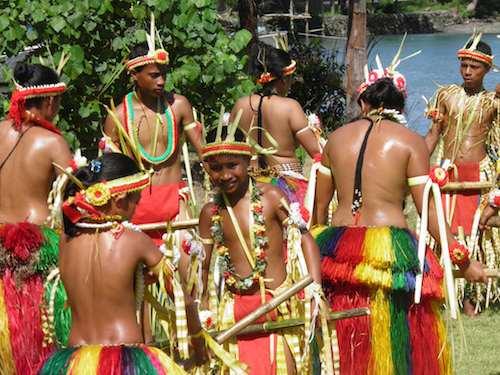Taken from an article by:
Matt Miller
Director of communications for the Conservancy’s Idaho program.
As I traveled around the islands of Micronesia, I repeatedly heard people voice the same words: Moving is not an option.
The often-tiny islands of Micronesia—and other other Pacific chains—are populated by people with diverse cultures, cultures shaped by the land and water over the centuries and even millennia.
Today, with ocean levels rising and fish stocks disappearing, they are facing the most serious threat to their cultures, their traditions and, indeed, their lives. And moving is not an option.
Water Is Rising
I visited two islands in the Federated States of Micronesia, Yap and Pohnpei. On Yap, large stone “money”—huge limestone disks larger than I am—are still used for ceremonial transactions. Village life remains the central part of Yapese culture, and they still rely on reefs for their livelihood and sustenance.
On Pohnpei, I hiked around huge ruins—rivaling what I saw at more famous sites like Machu Picchu and Tikal—built on top of artificially constructed islands that extend a mile onto the reef. Nan Madol, as this area is known, began construction in 500 BC. Today, Pohnpeians practice a rich and traditional form of agriculture that incorporates seamlessly into the forest.
Thousands of islands in the Pacific are still home to thriving human communities. People have worked out ways to balance the reef and the forest. But forces beyond their communities could shape the future of these islands.
There’s an old cliché that there are no atheists in foxholes. In that same spirit, perhaps it could be said that there are no climate change deniers on islands.
As people in the United States seem intent on arguing whether or not climate change is real, islanders are seeing sea levels rise and land disappear.
A group of performing artists from Pacific Island nations recently toured the United States with their show, Water is Rising, telling stories of climate change as faced by their communities.
But the threats to islands don’t end with climate change: Coral reefs put fish on the plate for millions of people. But around Micronesia and other islands, fish stocks are being depleted.
No food. No land. No place to go.
The islanders deserve better.
Traditional Knowledge, Cutting-Edge Science
Fortunately, many communities are leading efforts to ensure that they will continue to have fish on their plates, viable jobs and places to live.
They value self-sufficiency. Willy Kostka, director of the Micronesia Conservation Trust, put it this way: “If I can keep the food relief agencies out of this region, then I’ve succeeded. If the Red Cross is here, we’ve lost. To me, conservationists are in the front line of self-sufficiency.”
Communities recognize the importance of protecting marine areas to sustain fisheries. A locally-led initiative called theMicronesia Challenge–which includes the five governments, local communities, and local and global organizations (including the Conservancy)—has a goal to protect to protect 30 percent of the near-shore marine resources across Micronesia by 2020.
These are the reefs that keep fish on the table.
Such local efforts are complemented by cutting-edge science, such as sophisticated models of climate change impacts that can direct conservation efforts and help communities plan for the future.
“We don’t take our islands for granted,” says Kostka. “Every day I feel so lucky I was born here on Pohnpei. I feel very privileged to live here.”
The people of Micronesia are hopeful. They believe they can shape their own future.
A difficult truth is that some factors—climate change, depletion of fisheries—are generated by countries far from the Pacific islands. The Micronesians are doing their part. Can we do ours?
There is much hope, but the water is rising. And moving is not an option.
(Image: Villagers on the Pacific island of Yap perform the stick dance. Image credit: ©Matt Miller.)

No comments:
Post a Comment